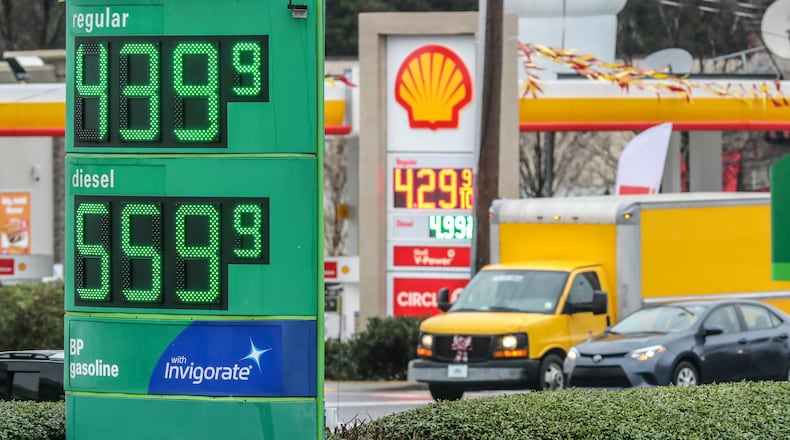Editor’s note: Story updated about noon Wednesday with latest gasoline price data.
Motorists and businesses are still feeling the sting of high fuel prices, but the cost of gasoline in metro Atlanta has fallen nearly every day for the past month.
The average price for a gallon of regular in metro Atlanta mid-Wednesday was $4.23, down 13 cents from a week ago and 30 cents lower than it was a month ago at its peak, according to Gas Buddy, which tracks fuel prices nationally.
Higher gas costs have helped drive consumer prices to a 40-year high, with consumer prices 9.1% higher in June than a year earlier, according to government figures released Wednesday. So the recent decline — coming since that calculation — is a glimmer of hope that inflation might have peaked.
And the gas price decline should continue, wrote Patrick De Haan, head of Gas Buddy’s petroleum analysis, on the firm’s blog.
“As long as oil prices remain cooperative and as long as refinery production of gasoline remains strong,” he said.
Oil prices have fallen roughly 20% in the past month.
Prices have fallen nearly every day for a month, the longest decline since the start of the pandemic in 2020, but that still leaves them far above the levels of a year ago, when they averaged $2.92 a gallon in metro Atlanta.
High fuel costs hurt not only consumers, but squeeze businesses, and governments, too.
Higher prices for oil-based fuel like diesel has been especially painful for Georgia’s school systems, which must fuel tens of thousands of buses, said Sam Ham, former transportation director for Fulton County Schools.
“You’ve got to keep the buses running, so you have to go back to your superintendent and school board to get more funds,” said Ham. “The economic impact on districts affects all of us as taxpayers — and it’s huge.”
Demand is shifting toward vehicles that can run on propane, electrical power or natural gas, said Ham, now director of alternative power for Yancey Bus Sales, which markets and services buses made by Fort Valley-based Blue Bird Corp.
Georgia’s statewide average is slightly lower than the metro Atlanta average at $4.18 a gallon for regular gasoline.
In the spring, Gov. Brian Kemp suspended Georgia’s gas tax, later extending that order twice so that it is now set to expire in mid-August. The suspension cuts roughly 29-cents-a-gallon from retailers’ costs, but it’s virtually impossible to measure how much of that is passed along to drivers.
Georgia gas prices are now the third-lowest in the country, just a few cents-a-gallon higher than South Carolina and Mississippi. That compares to the most expensive state: California, where gasoline averages about $6 a gallon, and Hawaii, where it averages about $5.50.
Gas prices are often wielded as a political weapon and the recent price spikes have been no different. But experts say that the Biden Administration shouldn’t have been blamed for the rising prices, just as it shouldn’t get credit for the decline.
It’s more about supply and demand for global oil and gasoline, experts say.
Gas prices have also jumped in Japan, Canada and across Europe, a sign that fuel costs are immune to any single nation’s policies.
Early in the pandemic, when millions of drivers stayed home, demand for gas crashed and so did prices, dropping to about $1.60 a gallon in metro Atlanta. With demand ebbing, production fell for both oil and the gasoline made from it in refineries.
As drivers returned to the road, demand rose faster than production and prices climbed. They kept rising through last fall and then soared when Russia invaded Ukraine.
A holiday on federal gas taxes — which President Joe Biden has proposed — could cut 18.4 cents a gallon, if retailers pass all of it along.
On the supply side, the Biden administration has allowed oil companies to siphon a record amount of oil from the nation’s strategic reserve, lowering it by 20% in the past year. But that too has a limited impact, adding only a fraction of the 20 million barrels of oil the nation burns through each day.
The administration blames oil companies for not drilling on the thousands of leases they have which could add dramatically to supplies. But that production would take time and some companies say they are hesitant because they don’t know if prices will stay high enough to justify the investment.
Still, production is up: There are 277 more oil rigs operating at the start of July than there were a year earlier — a 58% increase, according to Baker Hughes, an industrial services company that tracks production.
While historically gas prices rise and fall along with global oil prices, in the short term they often depend on refinery production of the gasoline that actually flows from the pump. And the current supply-demand balance is precarious: Refineries are working at near full-tilt.
A hurricane in the Gulf of Mexico that shut down rigs and refineries could push prices sharply higher.
Average gallon of regular, metro Atlanta
Wednesday: $4.23
Week ago: $4.36
Month ago: $4.53
Year ago: $2.92
Oil production, average U.S., per day
June 2018: 10.9 million barrels
June 2019: 12.2 million barrels
June 2020: 10.9 million barrels
June 2021: 11.1 million barrels
June 2022: 12.0 million barrels
Oil production, number of rigs
In operation, July 2018: 1,052
In operation, July 2019: 963
In operation, July 2020: 263
In operation, July 2021: 475
In operation, July 2022: 752
Sources: GasBuddy, Baker Hughes, Energy Information Administration
About the Author
Keep Reading
The Latest
Featured




